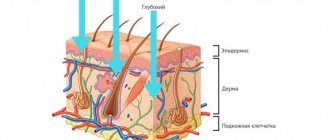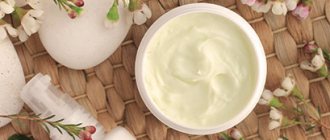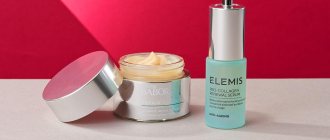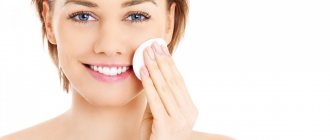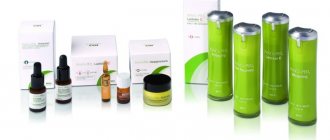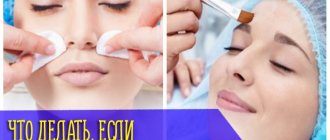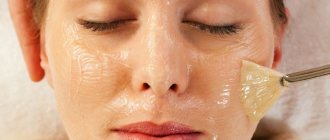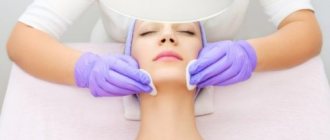Chemical peeling is a special intensive procedure aimed at exfoliating a thin layer of the epidermis in order to renew and eliminate imperfections. In the field of cosmetology, this is one of the most common techniques in rejuvenation and cleansing programs. The results of the procedure were also appreciated by the clients themselves, as evidenced by its popularity. However, it is important to ensure proper skin care after peeling. As a result of removing the top layer, it becomes vulnerable to external influences and requires careful attention.
Preparing for the peeling procedure
Care after peeling should be planned and a list of preliminary and restorative measures should be drawn up before it is carried out. And at the first stage you need to properly prepare the skin. Otherwise, it is quite possible that the effectiveness of the procedure will decrease or even cause negative reactions. To prevent such risks, you should follow simple rules:
- Maintain daily care. Usually, after peeling, the body intensively restores its usual balance, which is why the sebaceous glands work more actively. And this threatens with clogged pores and rashes. By preparing your skin in a timely manner, you can minimize the risk of post-peeling acne. To do this, you need to wash it with acidified water (with lemon), wipe your face with fresh juice from berries or fruits, which contain a high concentration of vitamin C. All these procedures should be done 10–14 days before facial peeling.
- Take vitamins for immunity. Facial peeling is a rather aggressive procedure that weakens the body. Against this background, the appearance of, for example, herpes is possible. Therefore, it is important to support the immune system and refuse the procedure during the period of acute respiratory viral infection; it is better to carry it out after recovery.
- Visit an allergist. It is especially important to see a doctor if you are going to have your face peeled for the first time. This will help avoid negative reactions to drugs.
It is also worth considering proper facial care after peeling. In this case, it is important to take into account the recommendations of the specialist and the characteristics of cosmetic products.
The problem of complications after peelings (chemical, mechanical, laser) is quite multifactorial. Complications can be caused by both endogenous causes (chronic diseases of blood vessels, heart, kidneys, liver, diabetes mellitus, etc.) and exogenous (incorrect choice of depth of exposure, incorrect preparation for the procedure, etc.)
Therefore, the main rule of a specialist to minimize risks is to carefully collect anamnesis and follow the procedure protocol, taking into account the individual characteristics of the patient. The task of any peeling (chemical, laser, mechanical) is to remove the surface layers of the skin to stimulate its regeneration processes, smooth out the relief, increase the level of moisture, etc.
And the complications after all types of peelings are essentially the same.
PREDICTED OR EXPECTED COMPLICATIONS
These complications are often called side effects, since their development after peeling is considered as a natural reaction of the body to skin trauma.
Erythema
Erythema is a marked redness caused by dilation of superficial blood vessels at the site of inflammation. Depending on the depth and aggressiveness of the effect, it can last from several hours (for example, after superficial peelings with α-hydroxy acids - no more than 3 hours) to several days (after medium peels, microdermabrasion it can last up to 5 days). Physiologically, erythema plays a protective role: due to increased microcirculation in the injured area, the process of removing toxins and tissue regeneration occurs faster.
An increase in the duration of erythema compared to expected may be considered a complication called persistent erythema.
Peeling skin
If after superficial peelings (almond, milk) peeling is practically not noticeable, and after superficial-medium peeling small-plate peeling can be observed (especially on the forehead and in the T-zone), then medium, and especially mid-deep, peelings are accompanied by large-plate desquamation and formation fibrin film. The patient must be warned about this and given recommendations on proper skin care.
To reduce the severity of peeling and correct the course of the rehabilitation period, moisturizing preparations, “Panthenol” cream or spray, “Bepanten” cream are prescribed.
Pastosity and swelling of the skin
Pastosity and swelling of the skin are the result of an inflammatory reaction in response to its damage. Swelling occurs due to increased permeability of small vessels and the release of a certain amount of liquid blood (plasma) into the tissue. It may appear 1–3 days after exposure and persist for up to several days (up to 5–7). More often it occurs after manipulations with the use of retinoids, laser and mechanical peels.
UNEXPECTED COMPLICATIONS
Immediate allergic reactions
Allergic reactions occur after chemical peels as the body’s response to contact with a particular acid. Erythema, itching, and increasing swelling up to Quincke's edema appear.
If the doctor has even minimal doubts about the patient’s allergy status, it makes sense to conduct an allergy test in the area behind the ear.
Formulations with retinol, ascorbic and kojic acids have the greatest allergenic potential. At the other pole is glycolic acid, which extremely rarely causes the complication under discussion.
Herpes after peeling.
Herpetic rashes
This complication may be the result of an incorrectly collected medical history, when the doctor does not take into account the frequency of exacerbations (if 2-3 times a year, this should alert the specialist). It is necessary to prescribe antiherpetic medications 3-4 days before the procedure and for the same time after peeling, or choose another technique that can solve the problem with which the patient came.
Herpetic eruptions can lead to the formation of atrophic scars, so preventing their development is an extremely important task.
Excess crust
Too thick a crust can form after medium-deep peels or dermabrasion. I note that to prevent its occurrence, the course of the recovery period should be assessed in time. Therefore, the patient must definitely come to see the doctor a week after the procedure.
If peeling is not yet observed, and the crust is very pronounced, then it may be necessary to prescribe physiotherapeutic procedures (for example, microcurrent therapy to enhance lymphatic drainage processes under the formed crust), reparative drugs (“Solcoseryl” gel, “Panthenol” cream or spray, “ Bepanten" cream for softening and moisturizing the crust).
Ointment products are not used because they create a film, a greenhouse effect, as a result of which the crust may come off prematurely.
The use of these drugs reduces the risk of cracking of the crust and resulting skin scars.
Skin sensitivity
Skin sensitivity may increase during a prolonged rehabilitation period. This may be caused by an incorrectly selected peeling composition, incorrectly selected laser intensity, or insufficient time between procedures when the skin has not yet had time to fully rehabilitate.
An increase in sensitivity should be a signal for the doctor to stop the course until the skin is completely restored.
Hypersensitivity of the skin is expressed in an excessive reaction to temperature, pain, mechanical influences or sunlight. This complication resolves on its own after 1–2 weeks, but
can persist for up to 1 year even with timely prescribed therapy.
Persistent erythema on the face after peeling.
DELAYED COMPLICATIONS
Persistent or persistent erythema
Persistent erythema more often occurs in patients with closely located vessels: in the presence of rosacea and telangiectasia, a tendency to hyperemia.
This complication can also appear on normal skin due to incorrectly selected peeling composition, exposure factor, or non-compliance with the procedure protocol. Foci of redness periodically appear and disappear. Their formation can be provoked by a variety of reasons: a change in cosmetic product, a change in air temperature. The presence of persistent erythema is an absolute contraindication for continuing the course of any peeling for a long time.
To correct persistent erythema, angioprotectors are prescribed (at least a month, depending on the result of use), cold lotions with chamomile, celandine, chlorhexidine digluconate (no longer than 2 weeks, so as not to dry out the skin), cosmeceuticals (at least a month, depending on the result of use) , the action of which is aimed at strengthening the walls of blood vessels.
In addition, a correction of the diet is required, which involves excluding spicy and pickled foods and alcohol from the diet.
If the doctor has any doubts, light peels with low concentrations of acids and close to neutral pH should be prescribed to assess the condition of the capillary bed.
The use of fractional lasers is the method of choice in the presence of an expanded capillary network and telangiectasia.
Hyperpigmentation
It is necessary to distinguish between false hyperpigmentation and true post-inflammatory. The first is a normal reaction of the body to aggressive influences and represents areas of “dried” grayish skin that peels off over time.
The second occurs as a result of an inadequate cellular response of melanocytes to the damaging effects of peeling. The most susceptible to these complications are patients with a tendency to develop pigment spots, with a history of endocrine or reproductive system problems, with skin phototypes IV–V, Mongoloid and Negroid races, as well as fair-skinned patients with various types of dyschromia. The risk increases with midline chemical peels and laser resurfacing.
To reduce the risk factor for the formation of post-inflammatory hyperpigmentation, careful selection of patients and correct pre-peeling preparation are necessary. Thus, when preparing the skin for chemical peels, tyrosinase inhibitor drugs are used: retinoic, kojic, azelaic acid, arbutin, ascorbic acid, etc. It is also advisable to perform the first professional procedure using a light superficial peel, which will prepare the skin for the effects of stronger compounds.
If we are talking about laser resurfacing, then the first procedures show the test (minimum) power of exposure using the method of selective photothermolysis.
During the post-peeling period, the doctor must prescribe adequate anti-inflammatory therapy, including tyrosinase inhibitors.
If hyperpigmentation does occur, you should first make sure whether it is post-inflammatory in nature or caused by sun exposure and ignoring sunscreens.
“Solar” pigmentation may gradually disappear if the patient begins to regularly use drugs with a high level of photoprotection. Therefore, it makes sense to wait two weeks before starting more serious manipulations.
If the doctor is dealing with pigmentation of traumatic origin, then the methods of choice may be whitening mesotherapy procedures or IPL technologies.
Scarring
Atrophic scars most often occur as a complication after chemical peels and dermabrasion, hypertrophic scars - after laser resurfacing.
There are two main reasons: the first is incomplete history taking (perhaps the doctor did not take into account the patient’s tendency to form scars), the second is non-compliance with the procedure protocol (incorrect choice of acid exposure duration, laser power, depth of exposure - affecting the papillary dermis layer).
The tendency to form scars is, in fact, a contraindication for serious effects. In such cases, it makes sense to offer the patient a course of superficial peels. And although the duration of such therapy will be much longer, tissue fibrosis will be avoided.
If scars do form, then their treatment tactics are usual: hypertrophic scars can be corrected using cryotherapy, fractional photothermolysis, and hormone injections; atrophic - by introducing hyaluronic acid, collagen, using a dermaroller.
Decreased skin turgor
The inflammatory process that occurs after medium and medium-deep peels can lead to degenerative changes in the dermis, manifested by a sharp decrease in turgor. The development of this complication is explained by the incorrect choice of impact force and incorrect assessment of the regenerative capabilities of the patient’s skin. To avoid this complication, peelings can be combined with biorevitalization, which is carried out in the intervals between peeling procedures. This will speed up the rehabilitation process, increase skin turgor, elasticity and moisture.
Demarcation line
The cause of this complication is considered to be a doctor’s error when performing chemical peels. It manifests itself as a clear line separating the area of skin on which the peeling composition was applied from the intact area. More often it appears in the parotid region, along the hairline, along the edge of the lower jaw.
To avoid such an unpleasant phenomenon, you should reduce the exposure time of peeling in areas adjacent to skin that has not been treated with a chemical composition. In other words, the acid here should be neutralized a little earlier than on the rest of the face.
In some cases, the demarcation line disappears on its own within 1.5–2 months. You can speed up this process with a course of superficial whitening peels and whitening preparations for home care.
Some complications are associated with insufficiently careful selection of patients for peeling procedures. Others are the result of incorrectly carried out pre-peel and post-peel measures. Complications can also arise through the fault of the patients themselves - if they do not follow the recommendations of a specialist or conceal from the doctor certain diseases that are an absolute or relative contraindication to invasive procedures.
Polina Uspenskaya, Ph.D., dermatologist, cosmetologist, head. Department of Cosmetology, Federal State Budgetary Institution Polyclinic No. 1, Administration of the President of the Russian Federation, Moscow
Some basic tips
How to care for your face after peeling is usually told by the specialist who carries out the procedure. But you should also listen to some basic advice:
- create a care program taking into account the time required for recovery;
- thoroughly cleanse the skin of the face;
- provide hydration;
- develop measures to protect against the negative influence of the external environment.
It is worth examining each stage in more detail.
Laser peeling
- age-related skin changes or impaired skin tone;
- stretch marks and scars;
- different depths of wrinkles;
- problems with excessive oily or dry skin;
- enlarged pores;
- hyperpigmentation;
- blackheads, acne and post-acne.
Advantages and disadvantages of the procedure
First of all, of course, about the advantages of this method.
Carbon laser is very effective. It is able to eliminate noticeable skin defects, achieving its rejuvenation and healing, and the result is visible after the first session. We must not forget about the high accuracy of the device. During the procedure, the cosmetologist can adjust both the depth of the beam and the area of skin exposed, depending on the need. The rejuvenation effect of carbon peeling is quite lasting; the skin remains ideal for at least more than a year. And, of course, the most important advantage is safety, provided that the procedure is carried out by a professional. There are also disadvantages, and they cannot be ignored. Firstly, there is a long recovery period after the procedure, which can last almost up to a month. The skin before recovery does not look very aesthetically pleasing, redness is noticeable, and often looks inflamed. Well, one more thing is the rather high cost, because the price of the peeling laser is quite high, plus only a trained and experienced specialist should carry out the procedure.
What types of peeling are used in modern cosmetology?
In modern cosmetology, various types of peeling are used, the differences from each other can be in the method of action on the skin and in the depth of penetration. Let's briefly talk about each of them.
Cosmetic peeling. It is produced using special creams that contain the smallest abrasive elements, through which the surface stratum corneum of the skin becomes thinner, easily peels off and is removed.
Mechanical peeling. This procedure is otherwise called dermabrasion and is skin polishing using special devices.
Physical peeling. The method is carried out either using ultrasound or an erbium laser.
Chemical peeling. It is carried out using fruit, salicylic, trichloroacetic and phenolic acid, depending on the depth of exposure.
Enzyme or enzymatic peeling. It is carried out using an enzyme-based mask.
Based on the depth of impact, peelings are classified as superficial, medium and deep. The first type, superficial, is used to prevent skin aging; the middle and deep ones are used to correct more serious skin defects.
After the procedure, a rejuvenating effect is achieved, the skin whitens and cleanses, becomes more elastic, pigment spots and other defects disappear.
What is the difference between laser peeling and resurfacing?
If we talk about the differences, it is worth recognizing that both procedures are performed with the same goal - to remove dead skin cells from the skin. And the difference between them lies in only one thing - the intensity of the laser effect. When grinding, a deeper cleansing of skin cells occurs, which is important, for example, with age-related changes or serious skin defects. Of course, resurfacing is a more effective method, since the skin remains in ideal condition 3-4 times longer than after peeling, but it is also more labor-intensive and more unpleasant for the patient. Therefore, the resurfacing procedure is recommended for people over 40 years old, when age-related changes become very noticeable.
Preparing for the laser peeling procedure
Naturally, like any cosmetic hardware procedure, laser peeling requires careful preparation. First of all, ideal cleanliness of the skin, for which, before starting the procedure, it is certainly treated with special cleansing products. However, this is not all; the patient himself must take care in advance to ensure that his body is prepared for the upcoming laser exposure. Firstly, you need to try to avoid direct exposure to sunlight for several days before the procedure. Secondly, do not use decorative cosmetics. Thirdly, do not drink alcohol. Otherwise, complications are possible and peeling will not bring satisfaction with its unpredictable results. The human body reacts differently to irritants, so it is better to play it safe and listen to the advice of experienced cosmetologists.
After cleaning the skin, an anesthetic is applied to it to reduce discomfort and burning when exposed to the laser. To protect the retina of the eyes during work, both the patient and the cosmetologist wear specially designed glasses. Next, the actual treatment of problem areas of the skin using the hardware method begins. In cosmetology clinics and peeling rooms today , carbon dioxide, carbon, and erbium lasers are used , and devices from different manufacturers differ quite significantly in functionality, price and efficiency.
What to do after laser peeling
It should be understood that the laser peeling procedure is quite complex to perform and a lot depends on how correctly the parameters of the equipment’s effect on the skin are selected, and on how you care for it during the rehabilitation period. It is about rehabilitation that we would like to talk separately.
Most professional cosmetologists, after peeling, give recommendations on skin care to protect against the negative effects of laser exposure. And they should be followed, because each person’s body reacts differently to outside interference. As a rule, swelling and redness will be observed during the first 24 hours after the session. You will feel a slight burning sensation. However, it is not recommended to wash your face with water on the first day; it is better to lubricate it with an anesthetic cream, which the cosmetologist will recommend. You should also not be in the sun, nor should you visit a bathhouse or solarium. You need to be more careful with the choice of products, excluding spicy, irritating, and alcohol-containing foods for a couple of days.
After 2 or 3 days, your skin will begin to peel. Do not under any circumstances resort to scrubs or gommages - this is fraught with not the most pleasant consequences. You should wash your face with water at a comfortable temperature, not too cold and not too hot, being careful. You should also not be in the sun, nor should you visit a bathhouse or solarium, for at least a month. Remember that 2-3 weeks of abstinence, which is how long the rehabilitation period after laser peeling usually lasts, will allow you to have young, healthy and smooth facial skin for a long time.
Cost of laser peeling
In different cosmetology centers and offices, the cost is on average approximately the same and, one might say, quite high. This is explained by the fact that the price of the peeling laser is by no means small; the procedure requires professional training of a cosmetologist in order to avoid complications, and the procedure takes quite a lot of time. However, thanks to the effectiveness of this technique and long-term preservation of skin youth, laser peeling retains and increases its popularity compared to other outdated methods of rejuvenation.
Post-peeling care program including recovery period
Rehabilitation takes approximately 2 weeks. How to restore facial skin after peeling? A special program should be developed taking into account the time that has passed since the procedure. During the first 12 or even 14 hours, skin care after peeling should be especially careful. Any exposure should be minimized:
- water procedures;
- touching;
- use of moisturizing creams, gels;
- UV exposure.
You should also take special care of your face after peeling and in the next few days (2-3). Restrictions apply to the use of fatty and moisturizing creams, being outdoors (high risk of excessive UV exposure), and physical activity.
For the remaining 7–10 days, skin care after peeling should also be careful. It is necessary to avoid the use of thick decorative cosmetics, the use of gommages and scrubs, forced removal of the crust, and visits to the steam room.
Glycolic peeling
A glycolic peel is a chemical peel using glycolic acid derived from sugar cane.
With glycolic peeling you can achieve:
- Renewal and improvement of skin structure.
- Increased skin tone.
How do we perform the glycolic peel procedure?
Your skin is cleansed with an acidified gel preparation, thoroughly dried with wipes, and then glycolic acid is applied to it. Sensations ranging from a slight tingling sensation to a more intense burning sensation depend on the sensitivity of the skin. During peeling, the doctor is nearby and, based on the condition of the skin, determines when to apply a neutralizer and rinse off the peeling with water. To reduce the feeling of heat and tingling, you can use a fan or direct a stream of air from a fan onto your face. After repeatedly washing off the peeling with water and stopping the tingling, a restorative cream is applied or the planned care continues (masks, massage).
How many glycolic peeling treatments are needed to achieve the effect?
The number of procedures depends on the complexity of the problem being solved - to refresh the skin or erase the signs of time. For simple tasks, a course of procedures for 1 “skin cycle” (6 weeks) is enough - you shed your old skin once and enjoy beautiful and renewed skin! To solve more complex problems - wrinkles, decreased tone, acne and post-acne - the skin must be “reset” and completely renewed 2 or even 3 times (12 or 18 weeks, respectively). We don’t recommend it anymore, because we remember that peeling is still stressful, and we don’t want to “button up” the skin and make you depressed. The frequency of procedures is 1 time every 7-14 days. The main rule is to do the next procedure only when the peeling is over, but not earlier than after 7 days (if there was no peeling). It is advisable not to extend the period by more than 14 days between procedures, so as not to roll back in achieving the cumulative effect of the course of glycolic peels.
How does glycolic peeling work?
Glycolic acid belongs to alpha hydroxy acids (fruit or AHA acids), which have gained popularity in modern cosmetics due to their unique abilities to renew the skin and improve its structure. The glycolic acid molecule has the smallest molecular weight among AHA acids, which promotes deep penetration into the skin. Fruit acids have been used in cosmetology for about 200 years, glycolic acid is the youngest and most progressive of them - it came to the service of youth and beauty in 1996.
Why do we need to pour acid on our skin for the sake of beauty, you ask a cosmetologist? To understand the meaning of the chemical peeling , you need to delve a little into the processes occurring in the skin. It won't be too tiring. Our skin is heterogeneous in its structure and consists of an upper layer - the epidermis and a deep layer - the dermis, which are separated by a dense basement membrane that does not allow anything foreign from the outside into the skin (including, unfortunately, active cosmetics). Glycolic peeling increases the permeability of the basement membrane - “windows” open in it, through which the necessary substances for moisturizing, rejuvenating, brightening and toning enter the deep layers of the skin.
glycolic peeling works in complex skin care procedures Fluoroxygen, Peelosophy Advanced, DMK Six-Layer Peel, Liquid Laser and Remove the Veil. This leads to a noticeable increase in skin tone and improvement in its color immediately after the procedure! And since these procedures work with the deep layer of skin, the results obtained are not fleeting, but we see (and record on a diagnostic video camera) a real improvement in indicators such as elasticity, hydration, reduction in the depth of wrinkles and pore size, uniformity in color and texture!
Glycolic peeling also accelerates the cell cycle - the time it takes for skin cells to pass from the deep layers to the surface and its natural exfoliation. The cell cycle is an important characteristic of healthy and youthful skin. Normally, it is 6 weeks: 4 weeks for skin cells to travel the “path” from the deep layers to the surface and 2 weeks for exfoliation, leading to renewal and “rebirth of the skin.” When the skin condition deviates from the norm (acne, age spots, pathological dryness, increased sensitivity, aging), the skin cycle lengthens. This process leads to the accumulation of “waste material” on the surface of the skin - old, non-viable cells, causing dullness, unevenness and blocking skin breathing. Glycolic acid gently and safely dissolves the intercellular cement that binds dead cells, thereby giving them the opportunity to slough off and make way for healthy young cells.
You have questions? [contact-form-7 404 “Not Found”]
Therefore, the skin glows after glycolic peeling. Makeup applies flawlessly to such polished skin, especially the next day, when slight redness (possible on sensitive skin) has passed and peeling has not yet begun (on the 3-4th day when using high concentrations of glycolic acid ). Acceleration of the cell cycle leads to activation of metabolism in the skin, which entails the formation of collagen and hyaluronic acid, which in turn makes the skin more elastic and hydrated! But a slowdown in the synthesis of collagen and hyaluronic acid is the main cause of skin aging (the first signs of which at the molecular level are detected at the age of 25). We can say that a course of glycolic peels leads to a decrease in the thickness of the horny layer, i.e. non-viable layer of the epidermis and thickening of the living dermis, where all processes to maintain the youth and beauty of the skin take place. This provides good chemical polishing of the skin surface (smoothing wrinkles, softening post-acne scars), as well as excellent tone and hydration - the skin is renewed, filled with collagen and hyaluronic acid.
Glycolic peeling is a dosed stress for the skin, which is needed to give a “shake-up” to the dormant processes of renewal and restoration. Since this is still stress, it is advisable to prepare the skin for it so that it does not give us a “hysterical reaction”, but reacts as we planned.
How to prepare your skin for glycolic peeling?
There are 3 ways: the first is ideal, the second is alternative and the third is a compromise.
- Ideal - includes a visit to a cosmetologist 2 weeks before the expected peeling, purchasing professional preparations for pre-peeling preparation at home and post-peeling recovery. The doctor diagnoses the skin and individually selects a cleanser, a night product with a certain percentage of acids and a daytime restorative cream. In this preparation option, you can immediately begin a course of peelings with 70% glycolic acid to obtain maximum effect while minimizing the risk of an inadequate reaction. The skin noticeably improves already during the pre-peel preparation, and the achieved results last longer. This option is for those clients who are used to planning events to improve their appearance.
- Alternative - involves a gradual increase in the concentration of glycolic acid and reaching 70% in 2-3 procedures. Suitable for those clients who do not want to purchase pre-peel preparation, do not have serious peeling goals, but simply want to improve the condition of their skin. But on pospeeling restorative preparations, Experts insist that 90% of the success of peeling depends on how young skin is accepted: how protected it is from external aggression and supplied with all the necessary high-quality substances.
- A compromise - we immediately apply 70% glycolic acid, but for a very short time, which we increase with each procedure. Also an option, but for those who are ready for redness, peeling and, in general, love extreme sports. This path can only be taken with those clients whose skin has already encountered acid peels and is not classified as sensitive, seborrheic or thin. Post-peeling preparations for rehabilitation are an urgent need!
Contraindications for glycolic peeling:
- violation of the integrity of the skin - fresh abrasions, wounds, etc., so it is better for men to shave the evening before the procedure, and for girls not to squeeze out pimples on their own 3 days before the procedure (acid will get in and it will burn strongly, and the penetration of the acid will be deeper and less predictable );
- acute herpes - postpone peeling for 2 weeks;
- fresh tan - wait 2 weeks (just time for pre-peeling preparation);
- taking certain medications - you remember all the medications you took for 2 weeks, and the dermatologist decides when you can have peeling.
Possible side effects of glycolic peeling
The procedure is usually well tolerated, and in the hands of a professional it is an effective and safe tool for improving skin condition. We are convinced that a specialist who knows and loves skin will reciprocate with sincerity! But there is also a human factor - if the client does not listen to the cosmetologist’s instructions and sunbathes, refuses restorative care at home - pigment spots, severe peeling and irritation of the skin may appear. scars after glycolic peeling ; this complication occurs after medium-deep and deep peels.
What procedures can a glycolic peel be combined with for best results?
It is very good to combine peels with moisturizing treatments, because if peeling is the stick, then hydration is the carrot for the skin. This is especially true for weakened skin, which needs to be supported, soothed and nourished in between peels. These are care procedures such as Un stress or MezoVit, hardware hydration using ultrasonic injection of serums (LDG) or cryolifting. For slightly more resilient skin, we would offer a wonderful mesotherapy procedure with hyaluronic acid and vitamin C, and for non-allergic skin, peeling and mesotherapy in one procedure - mesopil or “flash of beauty”! Please also pay attention to almond peeling in Kiev, which you can sign up for with us.
When is the best time for glycolic peels?
Experienced cosmetologists advise visiting a cosmetologist for glycolic peeling in late autumn and early spring, but progressive ones say that this is not so, because the sun protection factor in daytime products must be present all year round to truly protect the skin from photoaging and neoplasms, so peelings can be done at any time of the year ! If you realize the need for creams with sunscreen factors in the heat, cold, and cloudy days, come for peeling at any time, and we will do an effective procedure!
Photos Before and After Glycolic Peeling: Reviews of the Glycolic Peeling Procedure:
Marina, 42 years old “It seems to me that my skin looks better now than in my youth! Glycolic peeling did its job: the complexion is even, the skin is so fresh, toned, no spots or rashes, no fine wrinkles are visible either. I want and want to look at myself in the mirror. It’s especially nice that you don’t have to apply a lot of makeup. In principle, I have already stopped using foundation and powder for daily makeup. Without them, the skin can breathe easier, and there is no need for it anymore. Yes, a glycolic peel is not a spa treatment, but the results are worth the effort. I recommend it to everyone who hasn’t made up their mind yet!” Alexandra, 35 years old “After pregnancy, I developed pigment spots, which, alas, did not go away. The glycolic peel along with Danne's Peel the Veil treatment worked wonders on my skin. It seems that, as in the advertising pictures, I took and took off my old skin! I did the procedure at the end of winter, but now, at the insistence of the cosmetologist, I use sunscreen regularly. The skin is elastic, the pores are narrowed, and most importantly, I got rid of age spots on my face. Thanks to cosmetologists Edith.”
Cleansing after peeling
Although the skin becomes vulnerable, home facial treatments cannot be ruled out. In particular, it is important to ensure gentle cleansing. Microdamages caused by exposure to chemical compounds can serve as conductors for quite severe and serious diseases of the epidermis.
Care after facial peeling should include delicate washes with a moisturizing and soothing effect. But you need to start using them after 2-3 days.
It is important to maintain hand hygiene. It's worth stocking up on antibacterial soap. Do not touch your face with dirty hands, including while washing.
Humidification programs
Care after peeling should also be aimed at restoring the water-lipid balance of the facial skin. The chemical treatment procedure itself has a negative impact on the nutrition of the epidermis, although it provides a very noticeable result: smoothes wrinkles, improves color and tone. This exfoliates the thin top layer of skin, requiring it to be moisturized to avoid drying out.
In facial care after peeling, it is worth including special products in the form of gels or fluids. Such compositions do not need to be thoroughly rubbed in, and due to their light texture, they quickly penetrate deep into the epidermal cells and nourish the skin with moisture.
Switching to balms and serums (products with denser compositions) is possible no earlier than after 3 days. It is better to choose products for sensitive skin types or those containing antioxidants and hyaluronic acid.
Advice. Before applying the cream after the peeling procedure, it is worth spraying thermal water on your face (mineral water is also suitable), it will help the skincare cosmetics absorb faster without rubbing or stretching the skin.
Protection from external influences
When planning a procedure, you should immediately create a program on how to care for your face after peeling. An obligatory point in it will be the protection of the skin, which after chemical exposure will be thinned and very susceptible to the external environment. In particular, ultraviolet radiation and sunlight. Even 5 minutes outside can cause burns or the appearance of age spots. Therefore, facial care after peeling must include sunscreen.
You should choose formulations with an SPF factor of at least 30.
Wind and low temperatures also have a negative impact. They will worsen peeling and redness. For this reason, you should carefully consider the choice of season for cosmetic procedures on the face; spring and autumn, when the sun is gentle and the air temperature is comfortable, are optimal.
